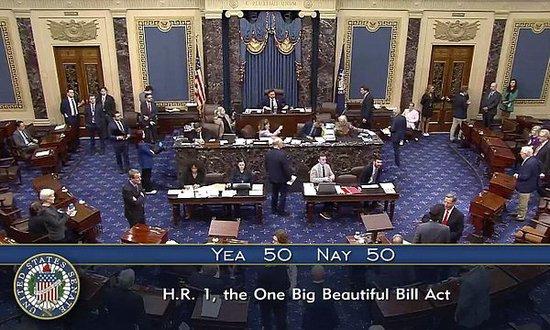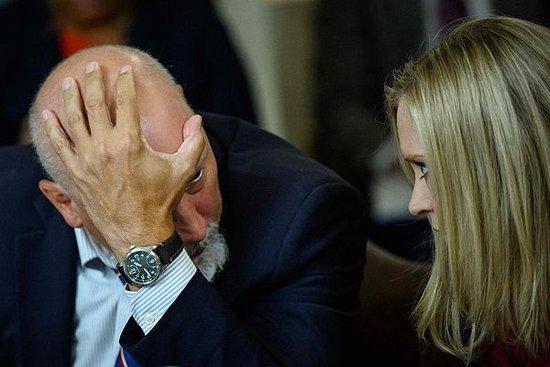

[Report by Occupy Watch Network, Xiao Chao Ran] Following a narrow victory in the House of Representatives in the United States on the 5th of May, with just one vote, the Senate remained deadlocked at a 50-50 tie. However, thanks to Vice President Pence’s crucial vote, President Trump’s major tax and spending reform bill was finally passed in the Senate.
According to reports from The Hill and the BBC on the same day, after a debate and vote lasting 27 hours on amendments, Pence’s “decisive vote” on that day brought significant “legislative victory” to Trump. Nevertheless, this bill, which Trump boasted as the so-called “One Big Beautiful Bill,” has been returned to the House of Representatives and continues to face numerous challenges due to its modifications in multiple aspects.
Trump had requested the Republican-controlled Congress to submit the final version of the bill before July 4th, promising to sign it into law. Before that, the House must approve the Senate’s changes. Now, after this round of “struggles,” Trump has hinted that it is difficult to pass the bill according to the original schedule, considering it might be around July 4th or the day itself.
On July 1st local time, The New York Times reported that the Republican-pushed “One Big Beautiful Bill” removed many generous tax credits for solar panels, wind turbines, electric vehicles, and other green technologies from the Inflation Reduction Act signed by former President Biden in 2022. This voting result indicates that Democrats’ efforts to make the bill more durable have failed.
The report mentioned an article published by the newspaper the day before, suggesting that Trump and Republicans’ “big beautiful bill” could further lag behind China, allowing China to gain a greater lead in the race for renewable energy technology development.
On July 1st, local time, during a Senate vote, Vice President Mike Pence broke the deadlock at 50-50, pushing through Trump’s massive tax cuts and spending reduction bill.
The “big beautiful bill” is considered the cornerstone of Trump’s second term agenda, which would permanently significantly reduce taxes, marking a policy implemented temporarily during his first term.
Previously, Democrats in the Senate attempted to block the bill’s passage by setting procedural obstacles, including requiring the Senate clerk to read the full text of the bill in its entirety on the spot and launching lengthy debate procedures regarding amendments. As a result, staff members spent all night reading the bill from Saturday until around 3 p.m. on Sunday, taking 16 hours.
The Senate began a marathon of voting sessions starting at 9:30 am local time on June 30th. In the voting, aside from all Democratic votes against it, Republican federal senators also abstained, including Tom Tillis, Rand Paul, and Susan Collins.
In the final stages, Senate Republican leaders spent several hours trying to reach a compromise with Lisa Murkowski, a Republican state senator from Alaska.
Murkoski, a Republican with independent thought, was concerned that the bill’s significant cuts to the medical assistance program and federal food aid funds would harm her hometown, leading the bill to teeter on the brink of failure.
Later, Republican negotiators re-crafted the terms for Alaska’s medical assistance and supplemental nutrition assistance program in the evening of July 1st, local time, in an effort to secure Murkoski’s support.
On July 1st, local time, at the Capitol in Washington D.C., after the Senate earlier passed the “Greater Together Act” earlier in the day, critics of the bill, including Texas Republican Congressman Chip Roy, who is a member of the Freedom Caucus, engaged with Indiana Republican Congressman Elaine Hayes during a hearing before the House Rules Committee.
When Murkoski ultimately cast her vote in favor, the final Senate vote reached a tie of 50-50. Subsequently, Vice President Mike Pence, a Republican serving as both the Senate Majority Leader and the Senate President pro tem, cast a “breaking the logjam” vote in a 50-50 tie, passing the amendment with a vote of 51-50.
“The amendment passed,” Pence said on the afternoon of July 1st, local time. At that moment, Senate Republicans applauded warmly, while Democrats sat in their seats, shaking their heads in disapproval.
Later that evening, President Trump celebrated the passage of the bill during a visit to an immigration detention center in Florida. He stated, “This is a great bill, it has something for everyone.”
However, The Hill noted that due to further cuts in federal medical assistance spending, accelerated elimination of clean energy tax credits, and changes to the limits on state and local tax credits, the “Greater Together Act” still faces challenges in the House of Representatives.
Due to the Senate’s amendments to the House version previously passed, at least six House Republicans have threatened to oppose the Senate bill. For instance, Thomas Massie, a Republican from Kentucky, is believed to be likely to vote against the amendment, as it would increase debt by more than $3 trillion.
The bill is expected to provide $160 billion for border security and immigration enforcement, $150 billion for increasing the Pentagon budget, and raise the debt ceiling by $5 trillion. It will extend the expiring 2017 Trump tax cuts, making the popular corporate tax reduction permanent, and introduce new tax relief for American workers through protection of tip income and overtime pay.
Additionally, the bill will allow individuals to deduct loan interest on purchases of American-made cars, and create “Trump Saver Accounts” for newborns and children under 18. The bill will also gradually phase out the renewable energy tax credit, which was a core component of the Biden administration’s Inflation Reduction Act.
BBC noted that the controversy surrounding the bill’s fiscal deficit, social welfare programs, and spending levels has presented significant obstacles for Republicans, causing the legislative process to stall and forcing Trump to admit “it’s hard” to pass the bill on schedule. “I really wanted to sign it into law on July 4th, but I think it’s going to be tough… I’d say it might be July 4th or around that time,” Trump had said earlier when leaving the White House for Florida.